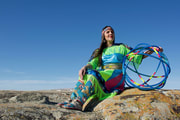|
This summer I was invited to represent Alberta First Nations at the Dance World Cup Opening Ceremonies and was a Delegate for the International Dance Council (CID) at the World Congress on Dance both held in Whistler BC, from July 3-5, 2015. This event hosted dancers and choreographer from around the world. The Dance World Cup was a competition and showcase of dancers, while the World Congress consisted of lectures, presentations, workshops and performances.
Sacred Dance and Storytelling This amazing opportunity to participate as the only First Nations dancer allowed me to learn other styles of dance from around the world and how they have evolved. Renu Sharma, from Mumbai, India, instructed a workshop on Kathak an Indian Classical Dance. She shared with us that the dance was originally done as a sacred dance only, but is now performed in public. This is similar to the hoop dance, which was traditionally only done as a healing ceremony, but today has evolved to be performed in public. Kathak is a storytelling dance, which again is also similar to the Hoop Dance, which is also a storytelling dance. The fact that these two Indigenous dance styles were originally ceremonial/ sacred dances and are also storytelling dances, suggests that storytelling and healing go hand in hand. Brain development research tells us that in order for us to make sense of and recover from a traumatic experience we need to reconcile the right (creative) and left (analytical) hemispheres of the brain. This requires telling a story that will appeal to both sides of the brain – rational and sequential, and at the same time, creative and emotional. This is something we can achieve through dance. When we dance from the heart, expressing our emotions, and at the same time tell our story, we are able to synthesize an experience to create healing. When we dance our stories we are able to create healing for ourselves and others. Dancing in the Four Directions Professor Patricia Torres of Mexico taught a workshop on Pre-Columbian dance. She shared that everything in the dance is done in fours and to the four directions. The dance begins around the drum in a clockwise direction, which represents the movement of the earth around the sun. Dr. Torres also shared that dance is taught by watching only. A workshop description of hers reads: Life enhancement through rituals. Our connection with others in the four corners of the world, the elements, the flavors of life all contained in our mathematical rhythms to feel the pulsations of the earth and our heart beating. Energy flow surrounding us and embracing all others in the circle. (www.malintzin.org) These teachings are similar to Hoop Dance teachings and powwow dancing. The hoop or circle is a sacred symbol that encompasses the four directions. Many Native dances from powwow and social dances to ceremonial dances are done clockwise, which follows the movement of the sun. These dances are also taught almost exclusively by watching only. When we dance in a circle and with the four directions we are dancing with the movement of the natural world. This helps us to understand and connect with the world around us. Learning by watching, helps us create our own awareness and discourse about what dancing is and what it means to us. In these ways we are creating our own story that is also interconnected with other stories. Daystar Rosalie Jones, says that: No one dancing Intertribal can dance only for technique, or only for ‘show’ or only for self. If it is anything at all, Intertribal Dance is the expression of the collective culture of the community, in its regalia, in its protocols and etiquettes, in its songs, and in the spirit present when one dances. (http://www.daystardance.com/value_indigenous_dance.html) I fully agree with her insight, but would add, by dancing with the movement of the earth, sun, and four directions we are also expressing the collective culture of the natural world and even the universe. This expression of collective culture can be interpreted as a form of storytelling. Dance is storytelling. It may tell a singular story, a collective story, or a universal story. Storytelling is an important part of healing, so dance your story and bring healing to yourself and the world! Thank you to the Alberta Foundation for the Arts- Cultural Relations Grant to help make this experience possible! Daystar Rosalie Jones. The Value of Indigenous Dance in Academia. http://daystardance.com/value_indigenous_dance.html The Brain Development information comes from a two hour presentation, for more information visit: http://www.albertafamilywellness.org/resources/video/how-brains-are-built-core-story-brain-development Patricia Torres. Pre-Columbian Dance Workshop. http://www.malintzin.org/index.php?option=com_content&view=article&id=110&Itemid=68 Patricia Torres. Intercultural Dance Workshop. http://www.tiahui.com.mx/
0 Comments
Leave a Reply. |
Nehiawsko Pikiskwew'Cree Woman Speaking' is a space to share my voice. My goal is to spread awareness and share wisdom as I learn and grow as a dancer, choreographer, and woman. My passion is to show the healing power of dance and culture. I love learning from elders, experience, and research and being able to synthesize Native and non-Native ways of knowing! Archives
November 2023
Categories
All
|
